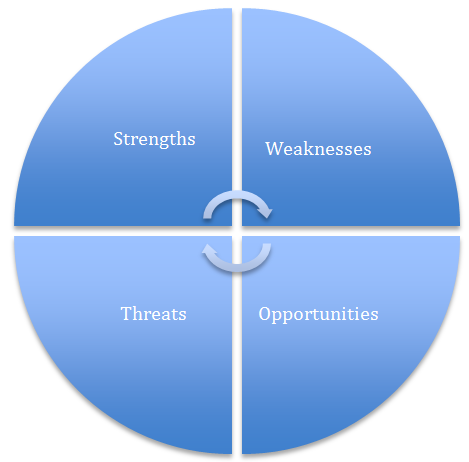The SWOT analysis is one of the basic concepts taught at business school and is essential for all real estate agents. The problem is, however, the only business school many agents go to is the School of Hard Knocks.
But that’s okay—you can be a graduate with honors of Hard Knocks University and still benefit from performing a SWOT analysis on your real estate business.
You may have all of the energy, drive and passion in the world—but without some sort of plan in place, even the most enthusiastic agents can suffer from massive diffusion, and find themselves confronted with too many tasks competing for the next hour of their time. As a result, none of their projects get very far, and the ones that do are poorly aligned with their needs and circumstances.
The Basics
The standard SWOT analysis, as we know it, was developed by Albert S. Humphrey, a successful management consultant in the ‘60s and ‘70s. Humphrey was looking for a tool that went beyond maximizing strengths and minimizing weaknesses; he wanted one that addressed how those strengths and weaknesses interacted with the broader business environment.
“SWOT” stands for:
- Strengths
- Weaknesses
- Threats
- Opportunities
Now, let’s talk about what SWOT isn’t. It’s not a business plan. It is, instead, a foundational document that can help you develop your business plan in a more intelligent way.
How to Format Your SWOT Analysis
Most people arrange SWOT in a pie-shape like this:

You can do that if you like, but it can be limiting. You need an awfully big circle to write everything in! Using an Excel spreadsheet will give you a lot more space, as will dividing a regular piece of printer paper into four quadrants.
Regardless of which option you choose, you can use four columns or four paragraphs—both work equally as well.
Example Real Estate SWOT Analysis
Here’s what an imaginary SWOT analysis might look like:
Strengths
- Solid understanding of real estate taxation
- Access to an affluent natural market
- Live in a desirable community with generally high real estate prices
- Well respected in the neighborhood/community/church/synagogue
- Connections with a good hard-money lender
- Expert on condominium association rules
- Willingness to do shoe-leather prospecting
- Fluent in Mandarin Chinese
- Good mentor
- Low monthly expenses
Weaknesses
- Substantial economic uncertainty in local area
- Lousy computer skills
- Overweight
- Limited savings
- No interest in property management
- No family money to speak of
- Limited budget for marketing/direct mail
- Poor Spanish skills (but lots of Spanish-speaking people in my market)
- Weak back office/poor systems in place
- Managing broker is new at the job
- Mine is the only income coming into the household
Threats
- Interest rates on the rise
- Overpriced stock market could implode, reducing the “wealth effect”
- Major storms in South Florida have been known to impact demand
- Agencies are recruiting heavily in my area, resulting in more competition
- Cash flow problems could possibly force me out of the business if I go more than a couple of months without a sale
Opportunities
- Local area is gentrifying
- Local community magazine giving me a deal on advertising
- New factory opening in area, attracting many jobs
- Military base means lots of people move in and out every three years, boosting transactions/turnover
- Become eligible for broker’s license this year
Find Your UVP
Every agent has a competitive advantage of some kind. It might be expertise in a certain neighborhood or with a certain market of people. What is your Unique Value Position, or UVP? What can you do, even as a new agent, that other agents would find hard to replicate, even if they threw a bunch of money at it?
If you’re a rookie, you might have to be a bit creative. But every agent has some advantage he or she can use to get a leg up in their first few appointments, at least. The longer you work at it, the broader that UVP can be—but it should still be focused.
Flesh Out Your SWOT
Once you have a list of your strengths, weaknesses, opportunities and threats written out, the next step is to develop a concrete plan of action. Your plan should do each of the following:
- Take advantage of every strength
- Minimize, mitigate or eliminate each weakness
- Take advantage of every opportunity
- Neutralize every threat
It’s not enough to have just a bullet point. Set a priority and give yourself a deadline for each item.
Here’s an example, building on the “Strengths” column above:
Strengths
- Solid understanding of real estate taxation
- Develop a PowerPoint presentation and class handouts for taxation seminar – Complete by July 10
- Reserve community room at Library – Complete by July 10
- Advertise seminar for real estate investors on real estate taxation in local publications – Complete by July 15
- Develop plan to capture emails and addresses of participants—Complete by July 1
- Advertise seminar on Social Media (Facebook, Twitter, etc.)—Complete by July 15
- Complete seminar (by earliest reservable date available)
And that’s just one “Strength.” There are other things you can do to capitalize on your strengths and unique knowledge of the business.
- Write an e-book
- Write a magazine article and submit it to the magazine you advertise in
- Get a regular column or guest spot on a blog
- Make an instructional video
- Put your seminar on the Web
Each of these tasks will have its own priority, list of implied subtasks and set of deadlines. It’s up to you how far you go.
Take Action
Of course, at some point, you have to stop typing and start putting your plan into action. Don’t fall victim to “paralysis by analysis.” Remember that a good plan executed now is better than a perfect plan that you never get around to implementing.
Yes, this SWOT analysis will be an evolving document. You will never be totally done. You can update it and refine it throughout your career, as your strengths and weaknesses evolve and as the market around you changes, and with it, the threats and opportunities in your area.
If you start with a strong SWOT analysis, flesh it out with a plan of action, add a priority to each task and set deadlines, then you are getting very close to a workable business plan.
After that, it is all about your own diligence, energy and execution. Good luck!
Get Your 2024 Marketing Plan Today!

Your business won’t magically grow on its own. You’ll need a marketing plan to generate more leads in 2024—that’s the first step to getting more clients and increasing your commission income.
Download our 2024 marketing planning guide today to get all of this and more:
- Simple, fill-out-as-you-go worksheets and templates
- Brand-building prompts (with tips & examples)
- S.W.O.T. analysis & goal-setting walkthroughs
- Marketing musts for 2024
- Social media marketing cheat sheet
- Much more!
Submit your email address below to have the “2024 Marketing Plan” sent to your inbox!
 800.978.5174
800.978.5174

Very well thought out plan
Very helpful…especially the flesh out tips. Thank you!
Essential tool for success
Very remarkable…updating.
I want to buy a property but I am confused about the tax for foreigners, can you help with further details?